Reporting Against a Multi-Fact Cluster Synonym
|
Topics: |
A cluster synonym is a synonym in which each segment is added to the cluster by reference using a CRFILE attribute that points to the base synonym. Child segments are joined to their parents using a JOIN WHERE attribute. A cluster Master File can have multiple root segments. In this case, the root segments are usually fact tables and the child segments are usually dimension tables, as found in a star schema. This type of structure is called a multi-fact cluster.
A dimension table can be a child of multiple fact tables (called a shared dimension) or be a child of a single fact table (called a non-shared dimension). In most cases, the fact tables are used for aggregation and the dimension tables are used for sorting.
The following image shows a simple multi-fact structure.
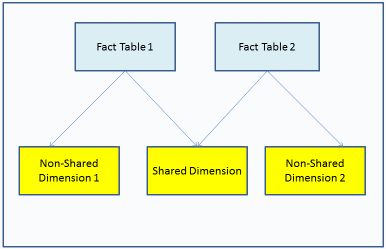
For information about creating a multi-fact cluster Master File, see the Describing Data With WebFOCUS Language manual.
The following list shows the rules for creating a report request against a multi-fact cluster Master File.
- You can report against only the fact tables.
- The first sort field in the request must be from a shared dimension.
- Any number of shared dimensions can be referenced in the request.
- Only a single non-shared dimension can be included in the request.
- The MATCH FILE command is not supported for reporting against a multi-fact synonym.
Example: Reporting Against a Multi-Fact Cluster Synonym
The following request against the WF_RETAIL_LITE multi-fact cluster synonym sums the COGS_US measure from the WF_RETAIL_SALES segment and the DAYSDELAYED measure from the WF_RETAIL_SHIPMENTS segment. The first BY field, BRAND, is in the shared dimension WF_RETAIL_PRODUCT. The second BY field, TIME_QTR, is from the non-shared dimension WF_RETAIL_TIME_DELIVERED.
TABLE FILE WF_RETAIL_LITE SUM COGS_US DAYSDELAYED BY BRAND BY WF_RETAIL_TIME_DELIVERED.TIME_QTR WHERE BRAND EQ 'Denon' OR 'Grado' WHERE DAYSDELAYED GT 1 ON TABLE SET PAGE NOLEAD ON TABLE SET STYLE * INCLUDE=IBFS:/FILE/IBI_HTML_DIR/ibi_themes/Warm.sty,$ END
The output is shown in the following image. The sum of DAYSDELAYED is totaled for each value of the shared dimension and, within each value of the shared dimension, for each value of the non-shared dimension.
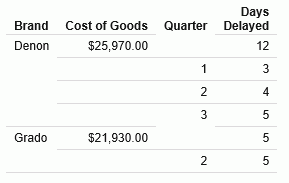
Adding a New Fact To Multi-Fact Synonyms: JOIN AS_ROOT
|
How to: |
The JOIN AS_ROOT command adds a new fact table as an additional root to an existing fact-based cluster (star schema). The source Master File has a parent fact segment and at least one child dimension segment. The JOIN AS_ROOT command supports a unique join from a child dimension segment (at any level) to an additional fact parent.
Syntax: How to Add an Additional Parent Segment
JOIN AS_ROOT sfld1 [AND sfld2 ...] IN [app1/]sfile TO UNIQUE tfld1 [AND tfld2 ...] IN [app2/]tfile AS jname END
where:
- sfld1 [AND sfld2 ...]
-
Are fields in the child (dimension) segment of the source file that match values of fields in the target file.
- [app1/]sfile
-
Is the source file.
- TO UNIQUE tfld1 [AND tfld2 ...]
-
Are fields in the target file that match values of fields in the child segment of the source file. The join must be unique.
- [app2/]tfile
-
Is the target file.
- jname
-
Is the join name.
- END
-
Is required to end the JOIN command.
Example: Joining AS_ROOT From the WebFOCUS Retail Data Source to an Excel File
The following request joins the product category and product subcategory fields in the WebFOCUS Retail data source to an Excel file named PROJECTED.
To generate the WebFOCUS Retail data source in the Web Console, click Tutorials from the Applications page.
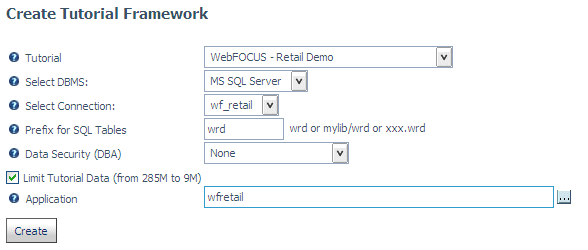
Select WebFOCUS - Retail Demo. Select your configured relational adapter (or select the flat file option if you do not have a relational adapter configured), check Limit Tutorial Data, and then click Create.
The Master File for the Excel File is:
FILENAME=PROJECTED, SUFFIX=DIREXCEL,
DATASET=app2/projected.xlsx, $
SEGMENT=PROJECTED, SEGTYPE=S0, $
FIELDNAME=PRODUCT_CATEGORY, ALIAS='Product Category', USAGE=A16V, ACTUAL=A16V,
MISSING=ON,
TITLE='Product Category',
WITHIN='*PRODUCT', $
FIELDNAME=PRODUCT_SUBCATEGORY, ALIAS='Product Subcategory', USAGE=A25V, ACTUAL=A25V,
MISSING=ON,
TITLE='Product Subcategory',
WITHIN=PRODUCT_CATEGORY, $
FIELDNAME=PROJECTED_COG, ALIAS=' Projected COG', USAGE=P15.2C, ACTUAL=A15,
MISSING=ON,
TITLE=' Projected COG', MEASURE_GROUP=PROJECTED,
PROPERTY=MEASURE, $
FIELDNAME=PROJECTED_SALE_UNITS, ALIAS=' Projected Sale Units', USAGE=I9, ACTUAL=A11,
MISSING=ON,
TITLE=' Projected Sale Units', MEASURE_GROUP=PROJECTED,
PROPERTY=MEASURE, $
MEASUREGROUP=PROJECTED, CAPTION='PROJECTED', $
DIMENSION=PRODUCT, CAPTION='Product', $
HIERARCHY=PRODUCT, CAPTION='Product', HRY_DIMENSION=PRODUCT, HRY_STRUCTURE=STANDARD, $ The following image shows the data in the Excel file.
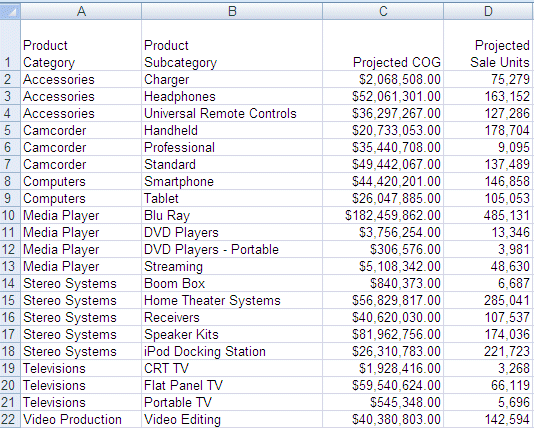
The following request joins from the wf_retail_product segment of the wf_retail data source to the excel file as a new root and reports from both parent segments:
JOIN AS_ROOT PRODUCT_CATEGORY AND PRODUCT_SUBCATEG IN WF_RETAIL TO UNIQUE PRODUCT_CATEGORY AND PRODUCT_SUBCATEGORY IN PROJECTED AS J1. END TABLE FILE WF_RETAIL SUM PROJECTED_SALE_UNITS REVENUE_US BY PRODUCT_CATEGORY ON TABLE SET PAGE NOPAGE END
The output is:
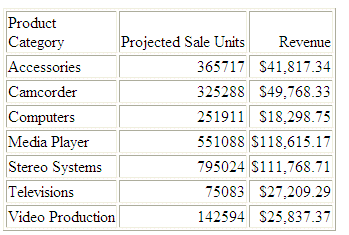
Joining From a Multi-Fact Synonym
Multi-parent synonyms are now supported as the source for a join to a single segment in a target synonym.
A join from a multi-parent synonym is subject to the following conditions:
- Conditional joins are not supported (JOIN WHERE).
- The join must be unique. That is, the TO ALL or TO MULTIPLE phrase is not supported.
- The target of the join cannot be a multi-parent synonym.
- The target of the JOIN must be a single segment, either in a single segment synonym or one segment in a single parent, multi-segment synonym.
- All fields in the JOIN must be FROM/TO a single segment. Any single segment in the source synonym can be used in the join.
Example: Joining From a Multi-Fact Synonym
The following Master File describes a multi-parent structure based on the WebFOCUS Retail tutorial. The two fact tables wf_retail_sales and wf_retail_shipments are parents of the dimension table wf_retail_product.
FILENAME=WF_RETAIL_MULTI_PARENT, $
SEGMENT=WF_RETAIL_SHIPMENTS, CRFILE=WFRETAIL/FACTS/WF_RETAIL_SHIPMENTS, CRINCLUDE=ALL,
DESCRIPTION='Shipments Fact', $
SEGMENT=WF_RETAIL_SALES, PARENT=., CRFILE=WFRETAIL/FACTS/WF_RETAIL_SALES, CRINCLUDE=ALL,
DESCRIPTION='Sales Fact', $
SEGMENT=WF_RETAIL_PRODUCT, CRFILE=WFRETAIL/DIMENSIONS/WF_RETAIL_PRODUCT, CRINCLUDE=ALL,
DESCRIPTION='Product Dimension', $
PARENT=WF_RETAIL_SHIPMENTS, SEGTYPE=KU,
JOIN_WHERE=WF_RETAIL_SHIPMENTS.ID_PRODUCT EQ WF_RETAIL_PRODUCT.ID_PRODUCT;, $
PARENT=WF_RETAIL_SALES, SEGTYPE=KU,
JOIN_WHERE=WF_RETAIL_SALES.ID_PRODUCT EQ WF_RETAIL_PRODUCT.ID_PRODUCT;, $ The following image shows the joins between these tables in the Synonym Editor of the Data Management Console (DMC).
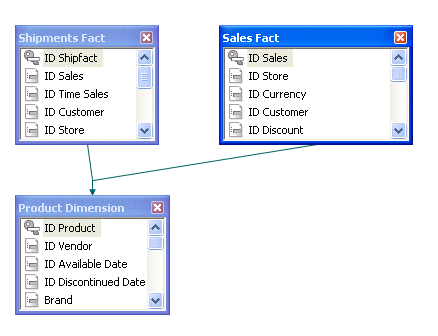
The following request joins the product segment to the dimension table wf_retail_vendor based on the vendor ID and issues a request against the joined structure:
JOIN ID_VENDOR IN WF_RETAIL_MULTI_PARENT TO ID_VENDOR IN WF_RETAIL_VENDOR AS J1 TABLE FILE WF_RETAIL_MULTI_PARENT SUM COGS_US DAYSDELAYED BY PRODUCT_CATEGORY BY VENDOR_NAME WHERE PRODUCT_CATEGORY LT 'S' ON TABLE SET PAGE NOPAGE END
The output is:
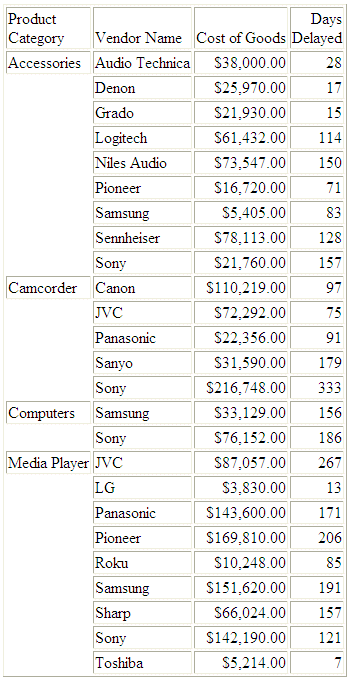
| WebFOCUS | |
|
Feedback |